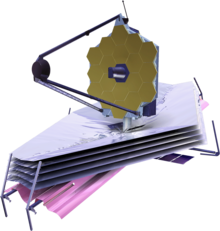
Back برنامج فلاج شيب Arabic Programa Flagship AST Velike strateške naučne misije BS پرۆژەی فلاگشیپ CKB Flagship-Programm German Programa Flagship Spanish Flagshipi programm Estonian برنامه فلگشیپ Persian Programme Flagship French תוכנית פלאגשיפ HE

NASA's large strategic science missions or large strategic missions, formerly known as Flagship missions or Flagship-class missions,[1][2] are the costliest and most capable NASA science spacecraft. Flagship missions exist within all four divisions of NASA's Science Mission Directorate (SMD): the astrophysics, Earth science, heliophysics and planetary science divisions.
"Large" refers to the budget of each mission, typically the most expensive mission in the scientific discipline. Within the Astrophysics Division and the Planetary Science Division, the large strategic missions are usually in excess of US$1 billion. Within Earth Science Division and Heliophysics Division, the large strategic missions are usually in excess of US$500 million.[3][2] "Strategic" refers to their role advancing multiple strategic priorities set forth in plans such as the Decadal Surveys.[2] "Science" marks these missions as primarily scientific in nature, under the Science Mission Directorate (SMD), as opposed to, e.g., human exploration missions under the Human Exploration and Operations Mission Directorate (HEOMD). The lines can be blurred, as when the Lunar Reconnaissance Orbiter began as a directed mission from the HEOMD, and was later transferred to the SMD.
Flagship missions are not under the purview of any larger "Flagship Program", unlike, e.g., Discovery-class missions that are under the purview of the Discovery Program. Unlike these competed classes that tender proposals through a competitive selection process, the development of Flagship missions is directed to a specific institution — usually a NASA center or the Jet Propulsion Laboratory — by the Science Mission Directorate.[2][1] Flagship missions are developed ad-hoc, with no predetermined launch cadence or uniform budget size. Flagship missions are always Class A missions:[4] high priority, very low risk.[2]
- ^ a b "NASA's 'Large Strategic' Science Missions Under the Microscope". www.aip.org. 13 October 2016. Retrieved 28 June 2019.
- ^ a b c d e National Academies of Sciences, Engineering, and Medicine (24 August 2017). Powering Science: NASA's Large Strategic Science Missions. The National Academies Press. doi:10.17226/24857. ISBN 9780309463836.
{{cite book}}: CS1 maint: multiple names: authors list (link) - ^ Powering Science: NASA's Large Strategic Science Missions (2017). The National Academies Press. page 10
- ^ "NASA Procedural Requirements: Risk Classification for NASA Payloads: Appendix B – Classification Considerations for NASA Class A–D Payloads".
 This article incorporates text from this source, which is in the public domain.
This article incorporates text from this source, which is in the public domain.
© MMXXIII Rich X Search. We shall prevail. All rights reserved. Rich X Search